That looks nice from a most simple XO principle a inductor and capacitor and what a beauty of a SR.
Byrtt,
Good to hear back from you. Not a bad XO design at all for a first time passive crossover
Thanks for all your help on this.
I had a TG9FD already mounted in a short vented aperiodic TL, so I put that on top of the sealed RS225-8 and connected the passive BW1 crossover that Byrtt designed (3.65mH & 57uF with 5R+5R padding on 10F/8424). The bezel of the 10F is round and I already had a rebated square bezel Dagger so I thought I would try the TG9FD first. Byrtt's recommendation was to place the HF unit 3inches behind the LF unit. The sensitivity of the TG9FD is not as high as the 10F, so the that was off. The acoustic XO was way too high with the RS225 having too much contribution above 1kHz such that the XO ended up near 1.2kHz. So I added a 2.5mH coil (1ohm series resistance) to the LF driver and this seems to pull the XO down to maybe 800Hz. Anyhow, here is the setup and the measurements.
You could try a zobel across the woofer if you have the parts. Leave the larger coil and start with about 40uf and 5R. Should bring down the RS225 nicely.
Measured frequency response and acoustic xo plot, there is a downward tilt of about 4 to 5 dB from 50hz to 15kHz - which I think many people prefer. This would probably go away with a higher sensitivity 10F (light grey is active 10F FAST system):
The 4ohm TG9FD would probably be a good sensitivity match. A little tilt can be a good thing, but it's nice to have the sensitivity to allow for some voicing.
I had a TG9FD already mounted in a short vented aperiodic TL, so I put that on top of the sealed RS225-8 and connected the passive BW1 crossover that Byrtt designed (3.65mH & 57uF with 5R+5R padding on 10F/8424). The bezel of the 10F is round and I already had a rebated square bezel Dagger so I thought I would try the TG9FD first. Byrtt's recommendation was to place the HF unit 3inches behind the LF unit. The sensitivity of the TG9FD is not as high as the 10F, so the that was off. The acoustic XO was way too high with the RS225 having too much contribution above 1kHz such that the XO ended up near 1.2kHz. So I added a 2.5mH coil (1ohm series resistance) to the LF driver and this seems to pull the XO down to maybe 800Hz. Anyhow, here is the setup and the measurements.
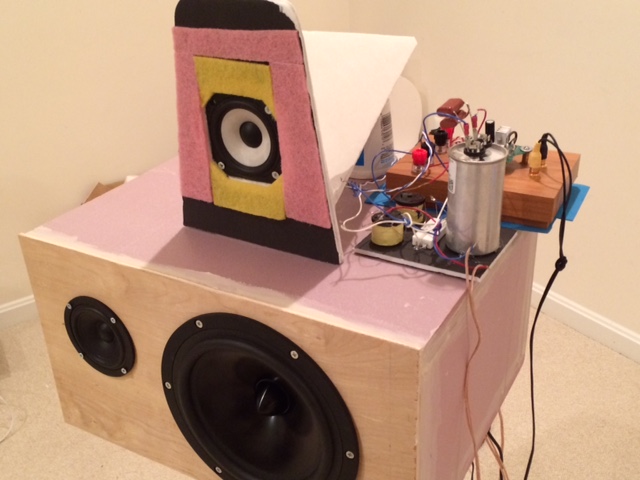
Measured frequency response and acoustic xo plot, there is a downward tilt of about 4 to 5 dB from 50hz to 15kHz - which I think many people prefer. This would probably go away with a higher sensitivity 10F (light grey is active 10F FAST system):
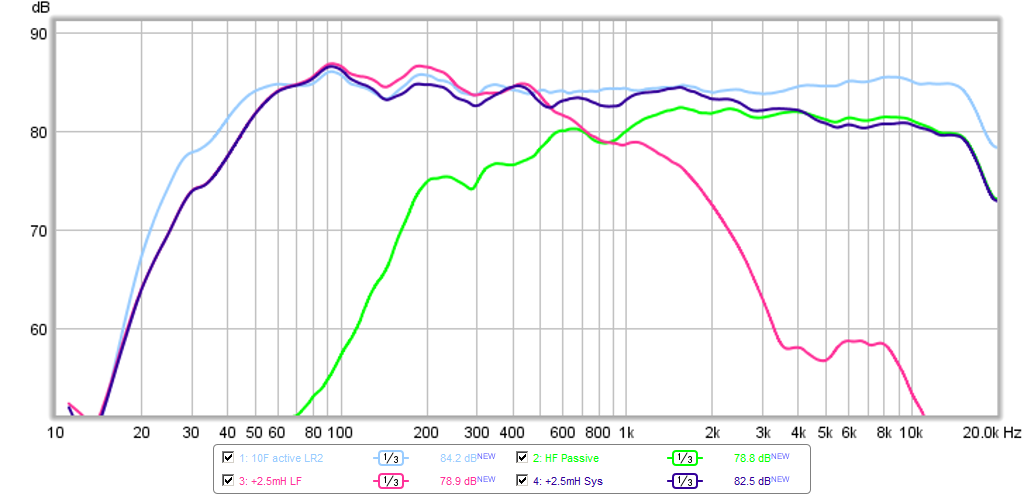
Measured absolute phase:

Measured impulse and step response (pretty nice) - the 3 inch setback seems to have done the trick with the time alignment:
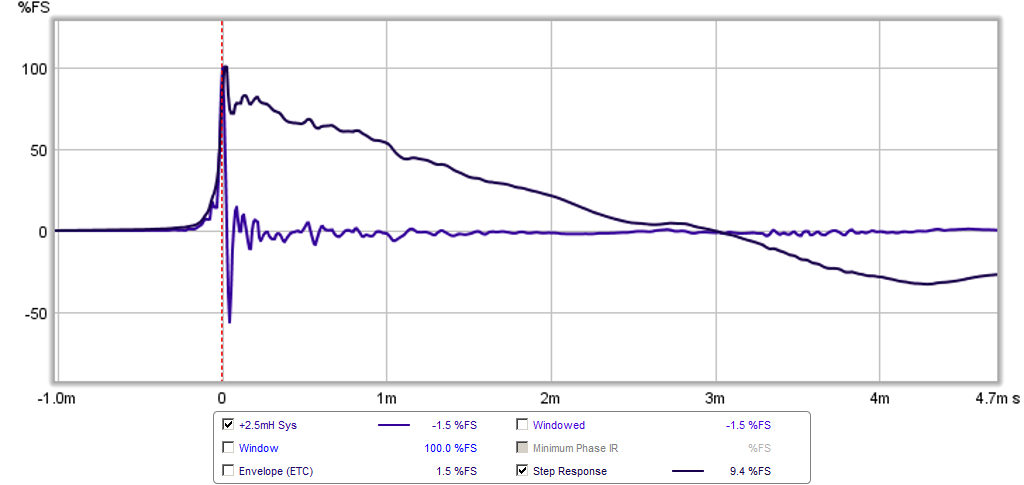
Here is the measured group delay - very nice at under +/-3ms from 35Hz and above:
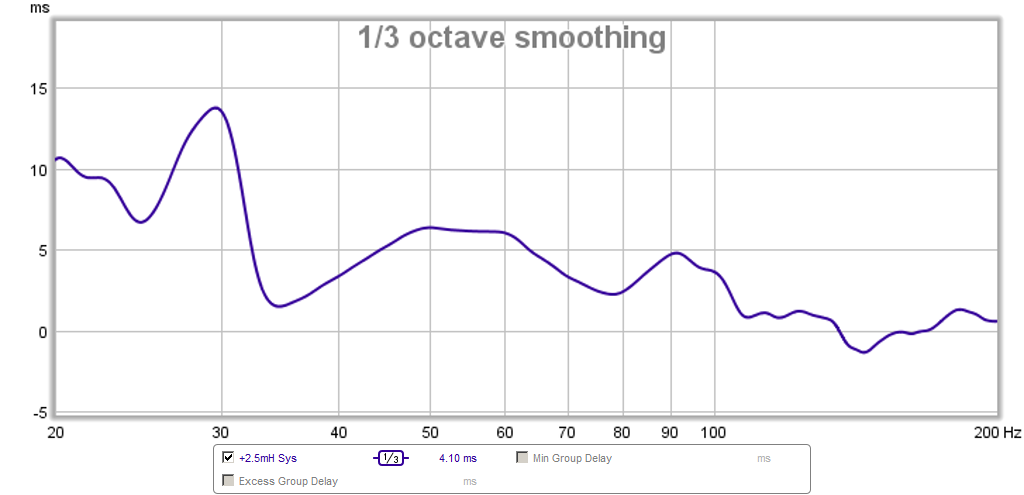
I am listening to it right now and it sounds pretty good. The bass is surprisingly good for a sealed box without any Linkwitz transform. Will report back later with more listening impressions.
I have a 4ohm faital Pro 3FE22 that might work (+6dB more sensitivity). I don't have the big cap for the Zobel. Maybe cheap it out with two electrolytics back to back?
I was just saying in general that the 4ohm might net a better match. It looks fine to me, so if it sounds good to you then I wouldn't worry about it. Also, If you cross lower, say around 400Hz, then baffle step will probably eat some more sensitivity from the Rs225.
If polarized then yes, back to back. Non polar are a better idea in a xo. Personally I almost always use electrolytic for large values in parallel. Especially since it's on your bass driver I doubt you would notice any difference except in your wallet.
If you have any tiny caps you could try bypassing the coil with it, something around .05 which is a weird size so you would have to series connect a couple of .10up or something. This creates a bottomless notch on the woofer's breakup. A resistor in series with the little cap will adjust the depth of the notch.
BTW, there is cancellation on either side of the xo, so maybe the mid needs more adjustment front to back.
The notch on the RS225 I mentioned would probably fix the issue in the treble. On the low end, did you stuff the TL for the TG9FD? If you could bring down that little peak at 200 it would probably help some, but I doubt that would really fix everything.
You probably know this, but if you measure impedance while adjusting the stuffing, you can get the most damping on the resonance peak
The notch on the RS225 I mentioned would probably fix the issue in the treble. On the low end, did you stuff the TL for the TG9FD? If you could bring down that little peak at 200 it would probably help some, but I doubt that would really fix everything.
You probably know this, but if you measure impedance while adjusting the stuffing, you can get the most damping on the resonance peak
BTW, there is cancellation on either side of the xo, so maybe the mid needs more adjustment front to back.
The notch on the RS225 I mentioned would probably fix the issue in the treble. On the low end, did you stuff the TL for the TG9FD? If you could bring down that little peak at 200 it would probably help some, but I doubt that would really fix everything.
You probably know this, but if you measure impedance while adjusting the stuffing, you can get the most damping on the resonance peak
I will give the notch filter a try - I have a bunch of smaller caps. For the big Zobel, I guess I need something like two 80uF's in series back-to-back to get a 40uF value? I have stuffed the TL and measured the impedance - it has dropped. I posted that somewhere before, I forget where. It's not flat but maybe 40% lower in peak height.
I need to tweak the setback distance and see if that helps the cancellation.
I will give the notch filter a try - I have a bunch of smaller caps. For the big Zobel, I guess I need something like two 80uF's in series back-to-back to get a 40uF value? I have stuffed the TL and measured the impedance - it has dropped. I posted that somewhere before, I forget where. It's not flat but maybe 40% lower in peak height.
I need to tweak the setback distance and see if that helps the cancellation.
Yes, 80 in series is 40. That's not textbook zobel values, maybe more like a damped second order, but the outcome is the same I guess
The value of the small cap is pretty critical, so you need to get very close. And it's dependant on the value of the coil- bigger coil, smaller cap and visa versa. If you measure the woofer, you'll see a sharp dip at the point of the notch. you can also try a resistor in series with the small cap with both across the coil. this will allow you adjust the depth of the notch.
This type of notch probably isn't the best for the broad breakup that the RS225 has because the notch is pretty narrow, but it should help some
If you can't fix the cancellation on the bottom by moving the mid, you can try a parallel coil after the cap it. Of course it won't be first order anymore
JBL LSR305 Ref Monitors
I just got the highly-acclaimed cost-effective LSR305 monitors to get a feel of how my reference monitors compare to a basic commercial product.
The reviews of the LSR305, in general, are all outstanding glowing reviews. If you can find a negative one, let me know... For between $225 to $300/pair depending on where you buy them, they are certainly something worth considering as a basic tool (like a measurement mic or woofer tester) if you want to have a means of listening to music with a neutral source. The LSR305 uses JBL's patented M2 waveguide with a fabric soft dome tweeter, internally, it handles the XO and EQ via DSP within its sound-processor/class D amp. Mids and bass are handled with an in-house 5in polycone woofer in a bass reflex box with a rounded rear-firing port. All this for $225/pair is just mind blowing.
First off, let's look at the magic that the M2 waveguide provides for the LSR305's polar response - truly amazing uniformity and linearity - I don't think I have ever seen or measured anything better with this regard. Less than 2dB variation from 0 deg to 45 deg below 14kHz. This is all gated at 4ms, mic was 0.5m away. The polar response is predictable and linear, meaning that the off axis response is never greater than the on axis response for any frequency. Note that my particular units do not measure as flat as they are advertised - not sure why:
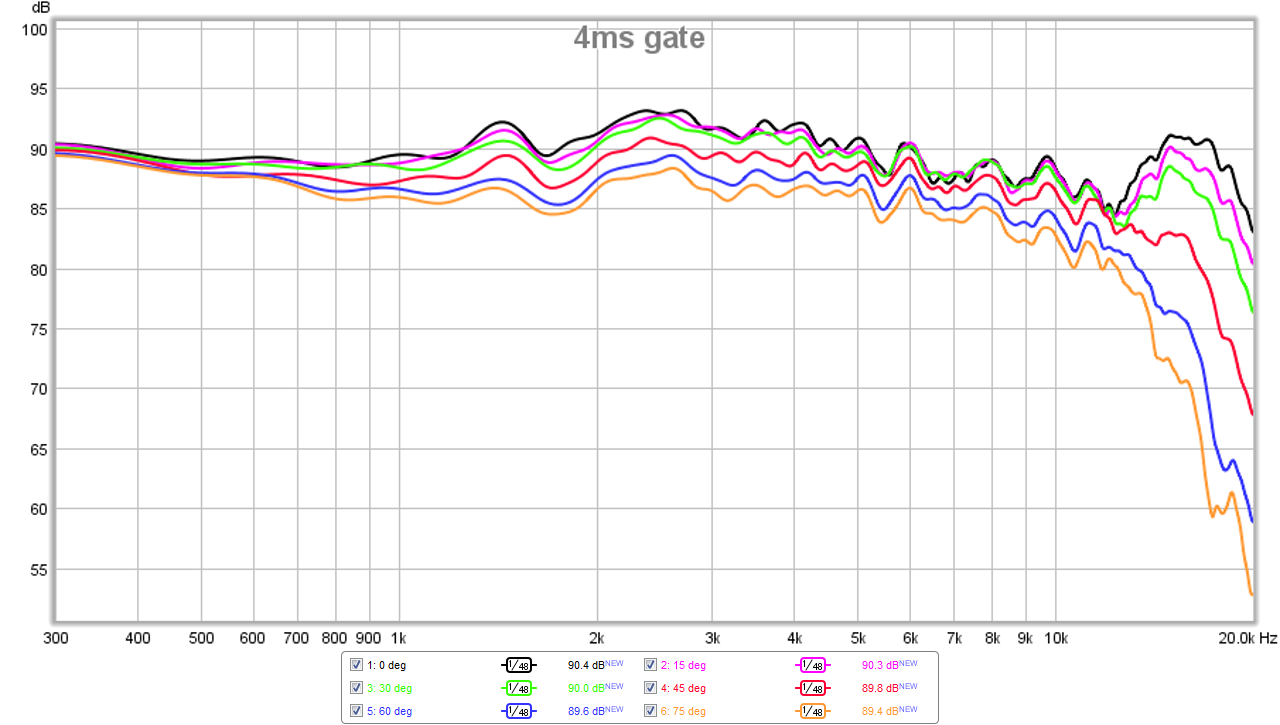
Here is the frequency response of LSR305 (red) compared vs the 10F/RS225 FAST (blue) with active LR2 XO, and the TG9FD/RS225 FAST (green) with passive BW1 XO - all at 4ms gate and 1/48th octave averaging:
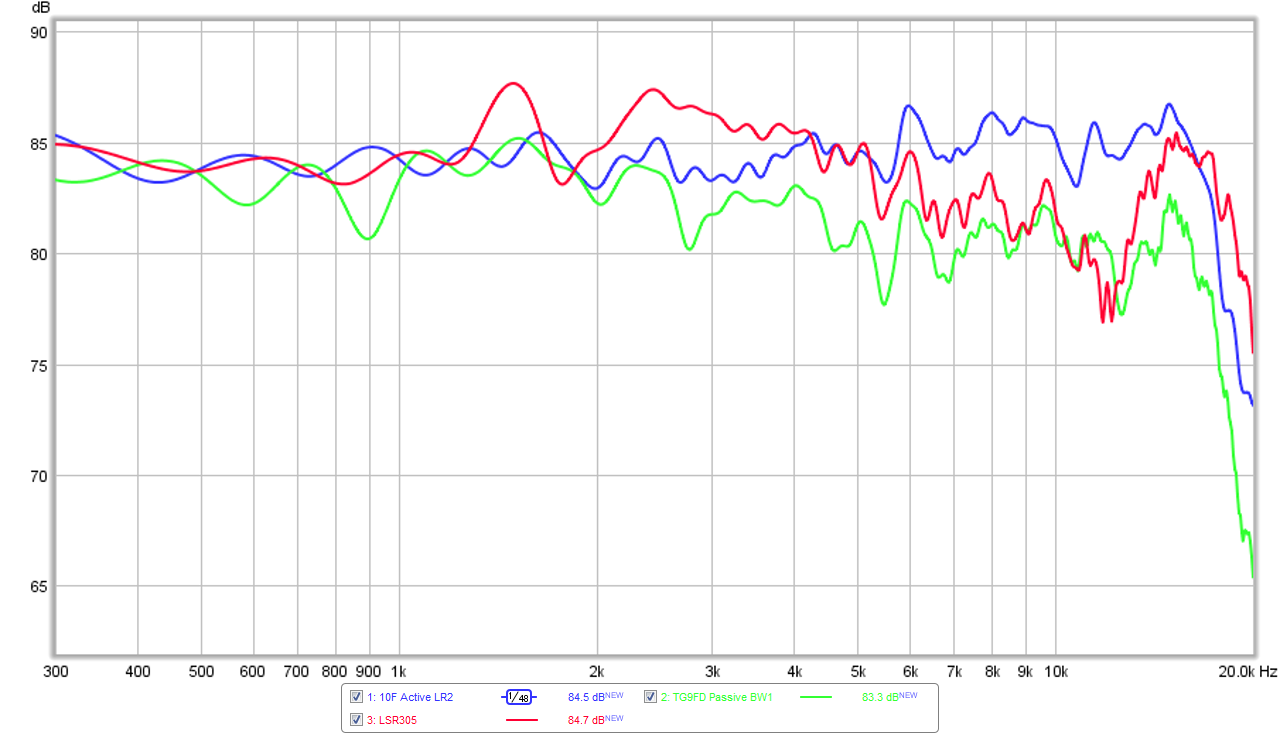
Here are the harmonic distortion performance for each compared:
LSR305 - between 60Hz and 600Hz there appears to be maybe box or plastic baffle induced vibration that causes higher distortion compared the 10F/RS225. There is another hump around 1kHz that is probably the thin plastic waveguide:
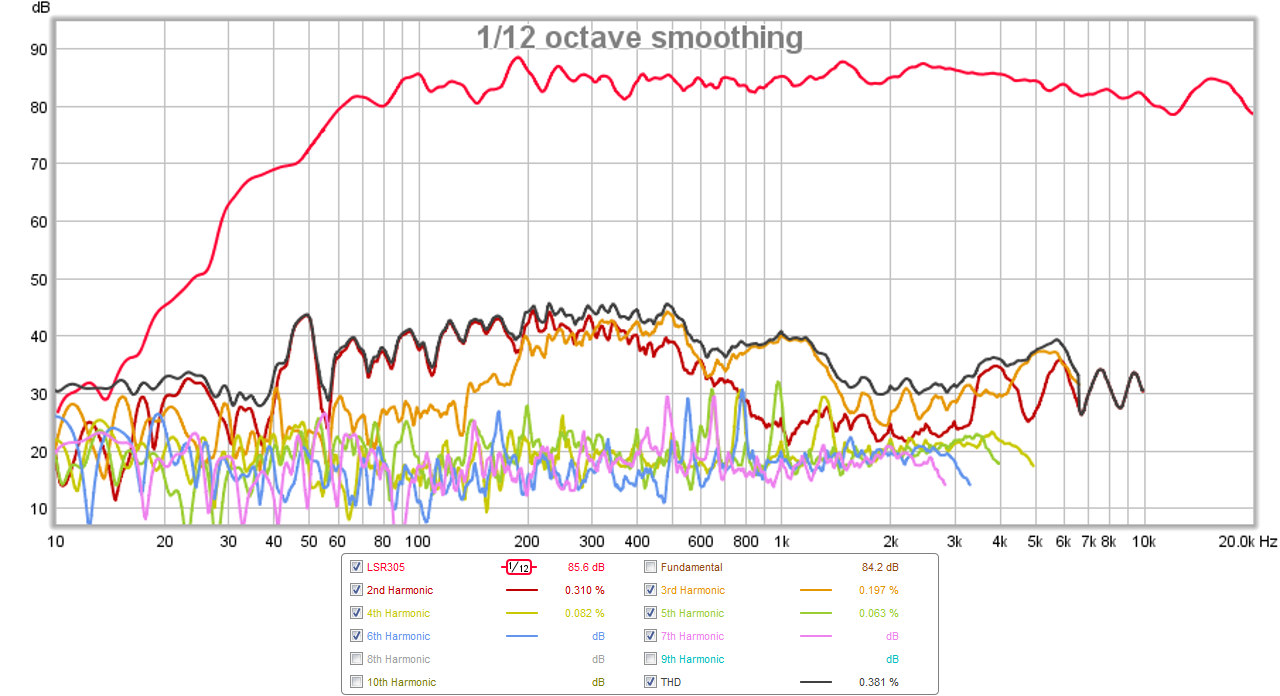
10F/RS225 FAST active XO, very clean with a rising distortion with lower frequencies due to cone excursion:
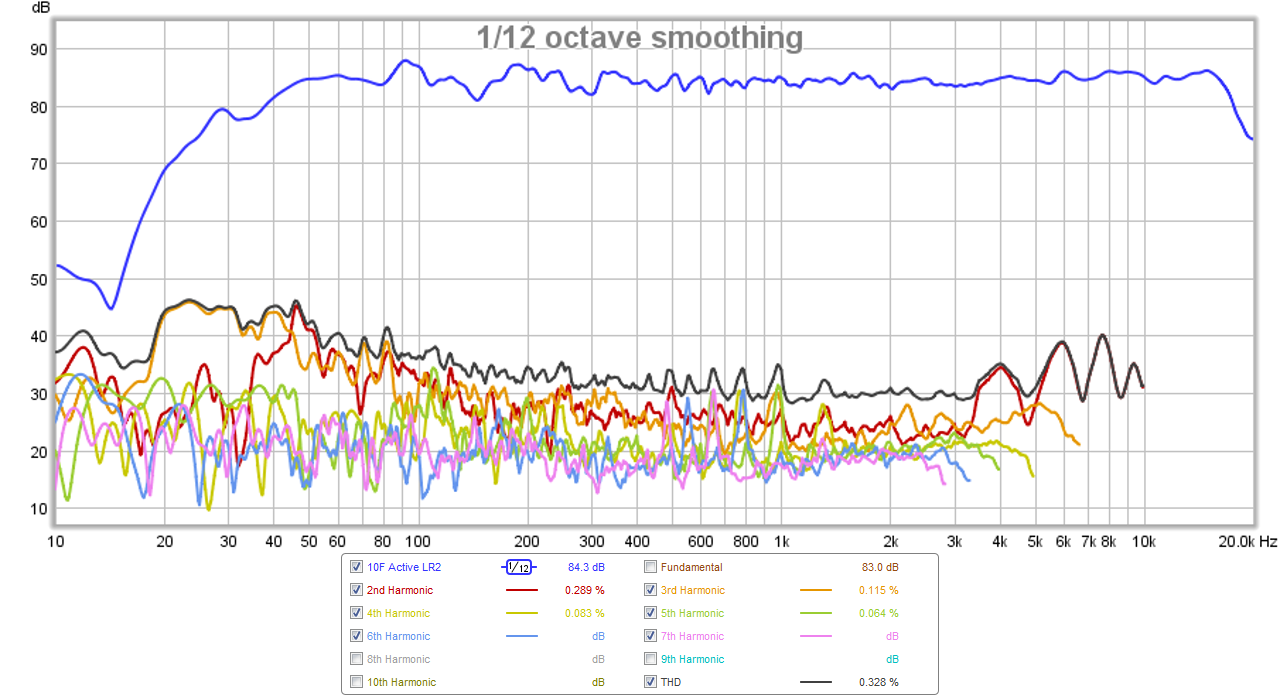
TG9FD/RS225 passive XO - there is a bump from 60Hz to 250Hz, whoch I suspect is from the externally mounted Dagger vibrating on top of the sealed cabinet as it was not securely fastened:
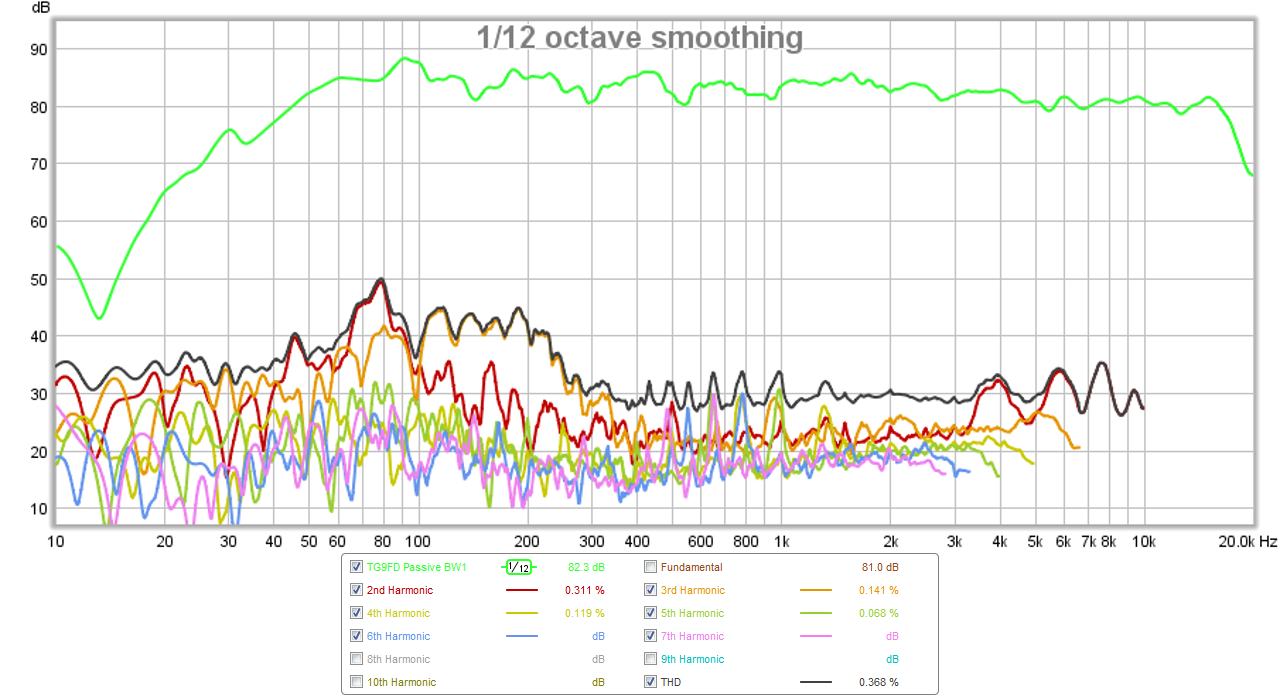
Here are the impulse and step responses compared:
LSR305 - kind of ugly with a small pre-ring and some hash followed by what is probably a boxiness hump:
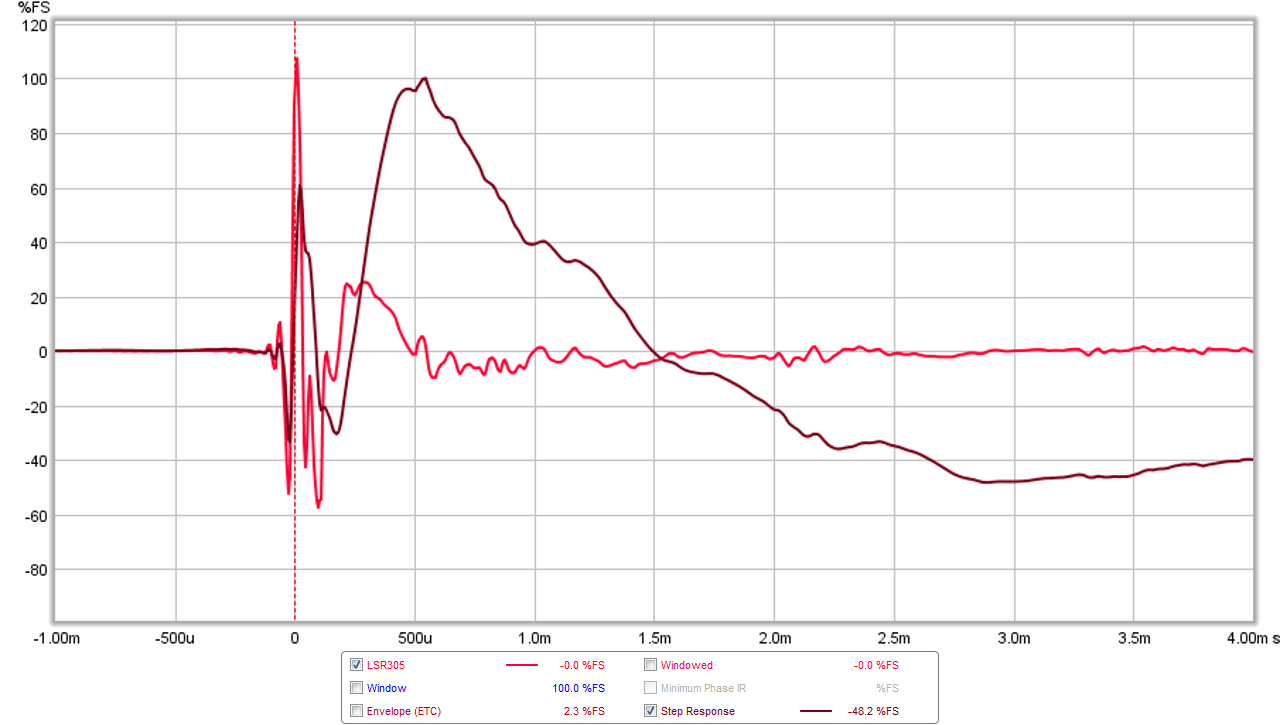
10F/RS225 active XO FAST - very clean but not a perfect due to higher order XO:
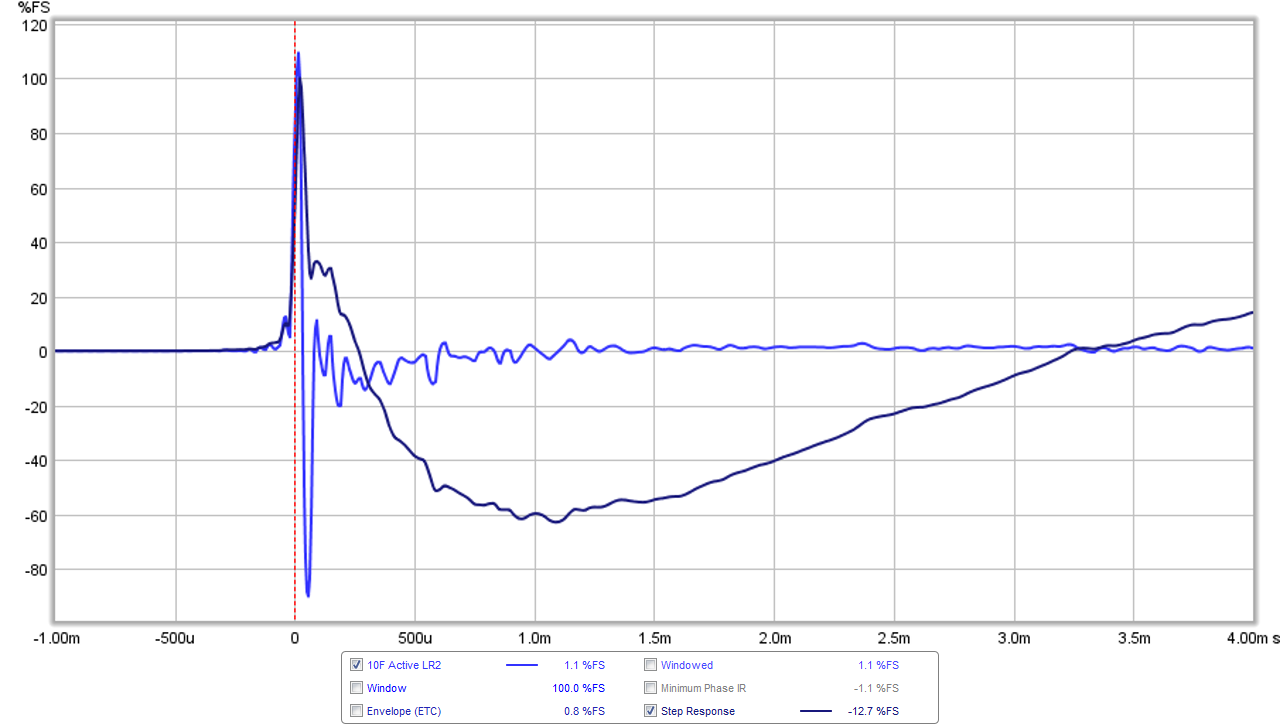
TG9FD/RS225 passsive XO FAST - clean and transient perfect due to 1st order XO:
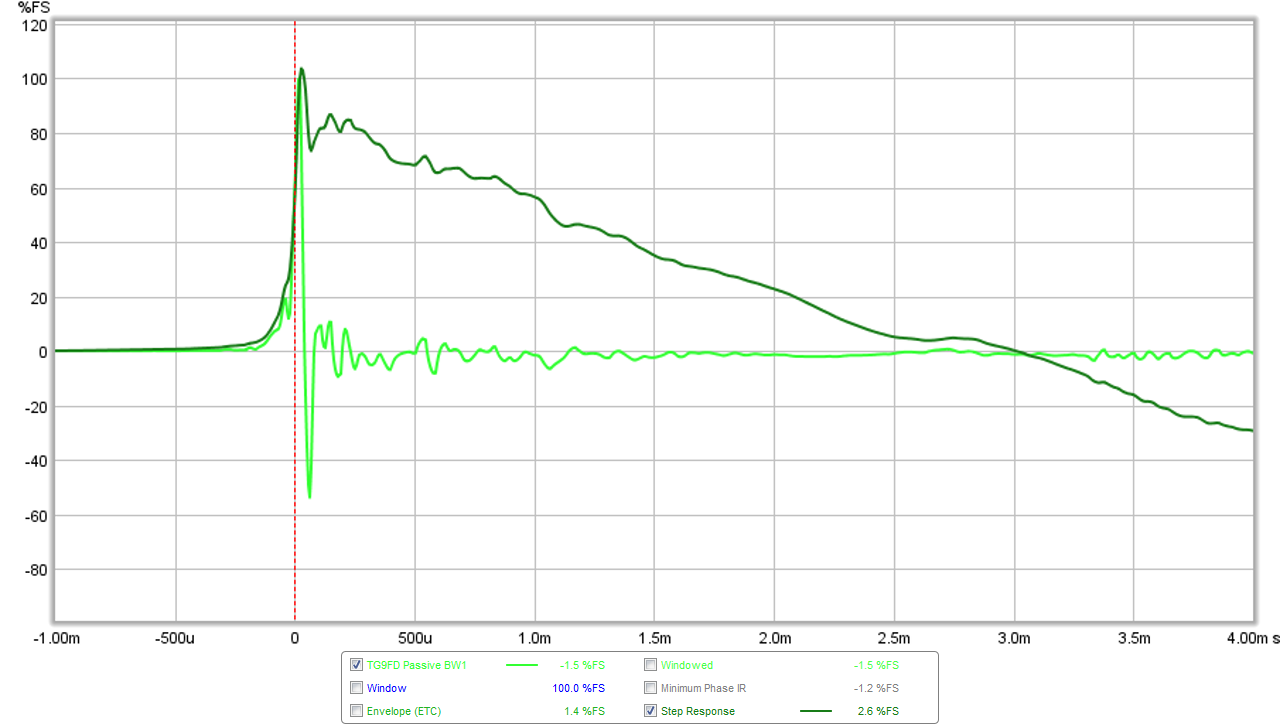
Here are the absolute and minimum phase responses compared:
LSR305 - lots of phase wrapping due to higher order filters:
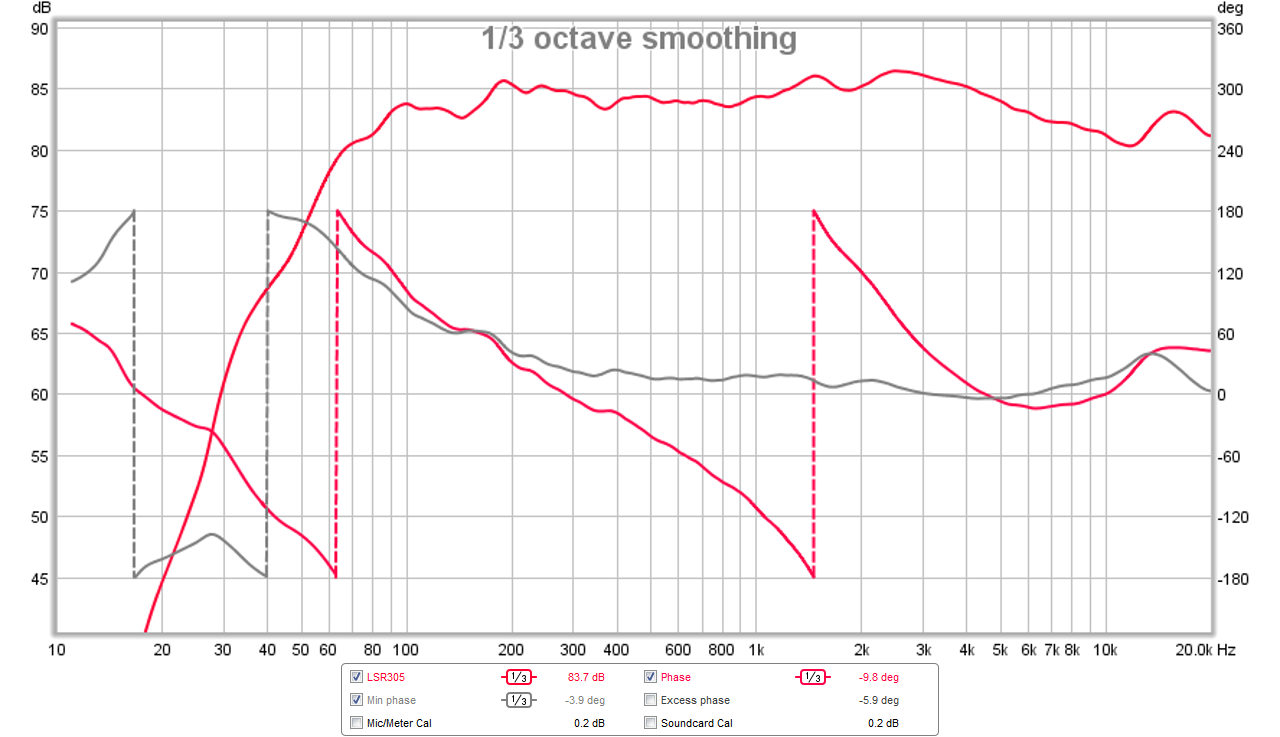
TG9FD/RS225 passive XO - very flat and linear:
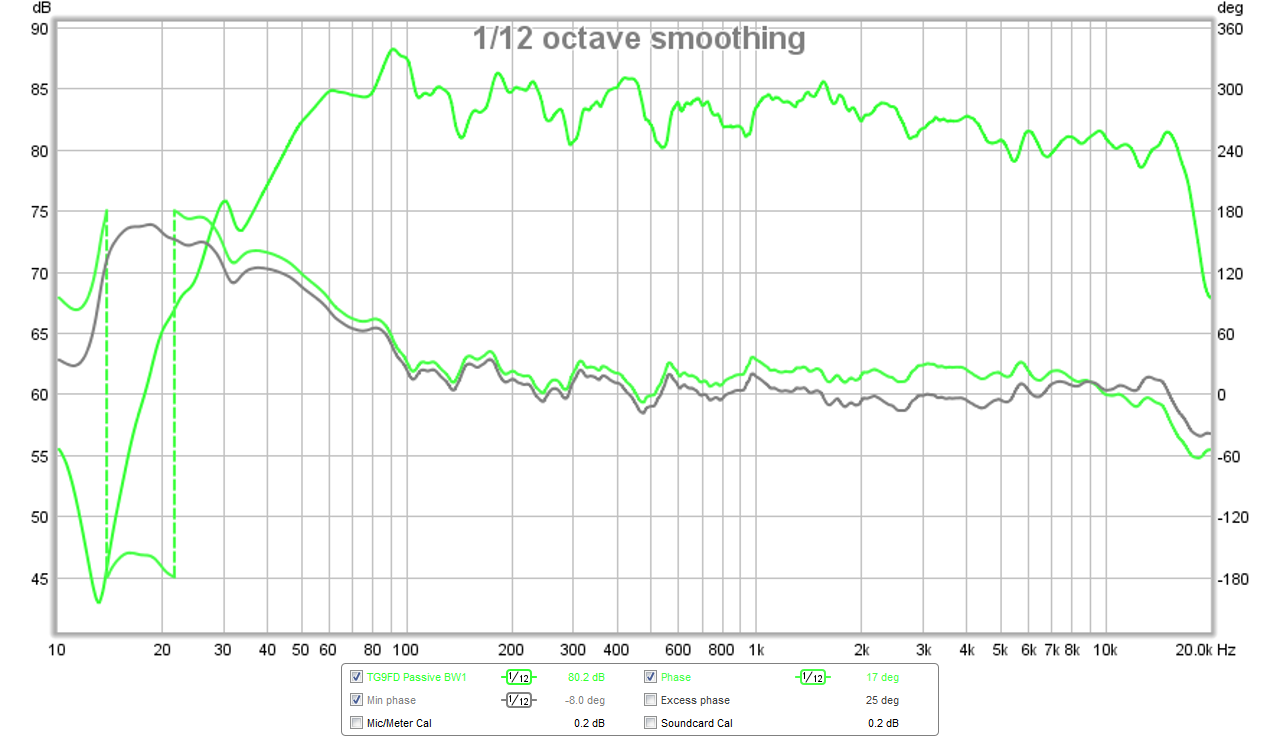
Ok, those are the measurements... obviously, the 10F/RS225 active and even the TG9FD /RS225 passive speakers measure better than the LSR305 in all areas except, probably (because I have not done it yet), the polar response. How do they sound? The LSR305's are probably the best sounding complete speakers you can buy for a little over $200. They are active so that is a bonus - just plug your phone or mp3 player into them using a 3.5mm to dual 1/4in TRS adapter cable.
Comparing the LSR305 to the 10F/RS225 - no comparison. My speakers blow them away in sound quality of realism, dynamics, spaciousness, even imaging - one would hope so considering the level of parts quality and performance used on my boxes. The resolution and detail of the 10F/8424 is really quite extraordinary. Pitted against a purpose built 1in soft dome tweeter in a waveguide - the highs on the 10F are not lacking to my ears, and sound exceptionally clear and transparent. It's not fair to compare the bass from a 5in vs an 8in. But I have to say that a sealed cabinet makes such clean precise bass, there is really no comparison here.
With that said, I would still recommend anyone needing a set of great value priced monitors to get the LSR305's. You just can't beat the price for a decent set of powered monitors.
I just got the highly-acclaimed cost-effective LSR305 monitors to get a feel of how my reference monitors compare to a basic commercial product.
The reviews of the LSR305, in general, are all outstanding glowing reviews. If you can find a negative one, let me know... For between $225 to $300/pair depending on where you buy them, they are certainly something worth considering as a basic tool (like a measurement mic or woofer tester) if you want to have a means of listening to music with a neutral source. The LSR305 uses JBL's patented M2 waveguide with a fabric soft dome tweeter, internally, it handles the XO and EQ via DSP within its sound-processor/class D amp. Mids and bass are handled with an in-house 5in polycone woofer in a bass reflex box with a rounded rear-firing port. All this for $225/pair is just mind blowing.
First off, let's look at the magic that the M2 waveguide provides for the LSR305's polar response - truly amazing uniformity and linearity - I don't think I have ever seen or measured anything better with this regard. Less than 2dB variation from 0 deg to 45 deg below 14kHz. This is all gated at 4ms, mic was 0.5m away. The polar response is predictable and linear, meaning that the off axis response is never greater than the on axis response for any frequency. Note that my particular units do not measure as flat as they are advertised - not sure why:

Here is the frequency response of LSR305 (red) compared vs the 10F/RS225 FAST (blue) with active LR2 XO, and the TG9FD/RS225 FAST (green) with passive BW1 XO - all at 4ms gate and 1/48th octave averaging:

Here are the harmonic distortion performance for each compared:
LSR305 - between 60Hz and 600Hz there appears to be maybe box or plastic baffle induced vibration that causes higher distortion compared the 10F/RS225. There is another hump around 1kHz that is probably the thin plastic waveguide:

10F/RS225 FAST active XO, very clean with a rising distortion with lower frequencies due to cone excursion:

TG9FD/RS225 passive XO - there is a bump from 60Hz to 250Hz, whoch I suspect is from the externally mounted Dagger vibrating on top of the sealed cabinet as it was not securely fastened:

Here are the impulse and step responses compared:
LSR305 - kind of ugly with a small pre-ring and some hash followed by what is probably a boxiness hump:

10F/RS225 active XO FAST - very clean but not a perfect due to higher order XO:

TG9FD/RS225 passsive XO FAST - clean and transient perfect due to 1st order XO:

Here are the absolute and minimum phase responses compared:
LSR305 - lots of phase wrapping due to higher order filters:

TG9FD/RS225 passive XO - very flat and linear:

Ok, those are the measurements... obviously, the 10F/RS225 active and even the TG9FD /RS225 passive speakers measure better than the LSR305 in all areas except, probably (because I have not done it yet), the polar response. How do they sound? The LSR305's are probably the best sounding complete speakers you can buy for a little over $200. They are active so that is a bonus - just plug your phone or mp3 player into them using a 3.5mm to dual 1/4in TRS adapter cable.
Comparing the LSR305 to the 10F/RS225 - no comparison. My speakers blow them away in sound quality of realism, dynamics, spaciousness, even imaging - one would hope so considering the level of parts quality and performance used on my boxes. The resolution and detail of the 10F/8424 is really quite extraordinary. Pitted against a purpose built 1in soft dome tweeter in a waveguide - the highs on the 10F are not lacking to my ears, and sound exceptionally clear and transparent. It's not fair to compare the bass from a 5in vs an 8in. But I have to say that a sealed cabinet makes such clean precise bass, there is really no comparison here.
With that said, I would still recommend anyone needing a set of great value priced monitors to get the LSR305's. You just can't beat the price for a decent set of powered monitors.
Attachments
-
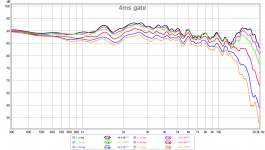 lsr305-polar-4ms.png154 KB · Views: 4,407
lsr305-polar-4ms.png154 KB · Views: 4,407 -
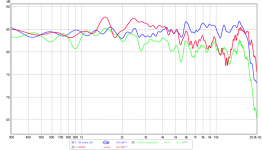 lsr305-tg9fd-10f-fast-copare-4ms.png130.8 KB · Views: 1,395
lsr305-tg9fd-10f-fast-copare-4ms.png130.8 KB · Views: 1,395 -
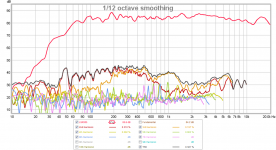 lsr305-hd.png305.9 KB · Views: 1,433
lsr305-hd.png305.9 KB · Views: 1,433 -
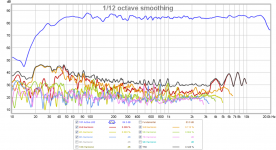 10f-fast-active-lr2-hd.png277 KB · Views: 1,180
10f-fast-active-lr2-hd.png277 KB · Views: 1,180 -
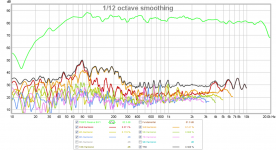 tg9fd-fast-passive-bw1-hd.png287 KB · Views: 780
tg9fd-fast-passive-bw1-hd.png287 KB · Views: 780 -
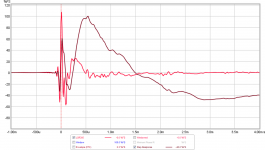 lsr305-ir.png105.5 KB · Views: 794
lsr305-ir.png105.5 KB · Views: 794 -
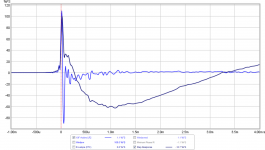 10f-fast-active-lr2-ir.png93.4 KB · Views: 794
10f-fast-active-lr2-ir.png93.4 KB · Views: 794 -
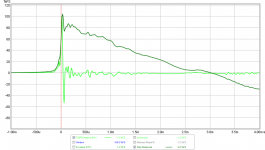 tg9fd-fast-passive-bw1-ir.png90.7 KB · Views: 776
tg9fd-fast-passive-bw1-ir.png90.7 KB · Views: 776 -
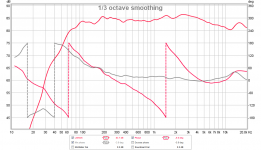 lsr305-phase.png144.9 KB · Views: 785
lsr305-phase.png144.9 KB · Views: 785 -
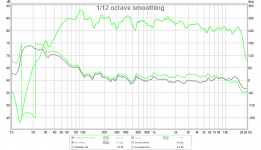 tg9fd-fast-passive-bw1-phase.png147.4 KB · Views: 775
tg9fd-fast-passive-bw1-phase.png147.4 KB · Views: 775
Last edited:
I think for overall sound quality, I prefer the active LR2 XO vs the passive or active BW1. The BW1 can work but as Satx pointed out, just because it's first order doesn't mean it's simple. I can see that a lot more components will be needed to shape the responses and to reduce the XO bleed thru due to the residual output of the woofer at the higher frequencies. The LR2 XO just sounds cleaner. You give up that transient snap though, but I only hear that on a few selected recordings. 95% of the time, I don't hear its effect.
But that is not to say that it can't sound better - I think with work and a lot more parts, the passive BW1 can't be made to sound great as Dunlavy et al have shown. In active DSP, it is work yet to shape all the responses prior to the BW1 xo. I still haven't been able to make it sound as clean as I would like.
But that is not to say that it can't sound better - I think with work and a lot more parts, the passive BW1 can't be made to sound great as Dunlavy et al have shown. In active DSP, it is work yet to shape all the responses prior to the BW1 xo. I still haven't been able to make it sound as clean as I would like.
Last edited:
Well I'm in love with the snap that makes you jump up from time to time  .
.
But the harmonics and ambience that's been saved is another big factor for me.
Not sure if you got to hear that with your setup. Probably has something to do with size as well.
Still hearing new stuff in otherwise familiar recordings. And I know it's not a frequency abnormality in my case.
It is still surprising me on a lot of recordings, much more than the figure you mention.
But there's nothing wrong with the cleaner sound of your LR2 setup.
I actually experienced both sounds in my Car. First order crossovers were like magic on certain songs. But due to woofer break up and things like that it never worked out for the majority of my music. So higher slopes were needed to keep me happy.
That's when I decided to chase the crossover less speaker to get rid of that particular problem. I'm glad I did.
I never liked 4th order slopes though, while playing with all kinds of variables in my car.
It didn't sound bad, not at all, and it would go loud and clear. Louder than the shallower sloped versions. But it didn't have any magic left. Just plain sterile music.
At least there I had a fixed listening position and could tailor the sound to that one spot.
I toned it down to LR2 there to be pleasing on most materials, using time alignment to keep all drivers in same polarity. That LR2 wasn't electrical LR2 but acoustical. Much like your 10F setup.
But the harmonics and ambience that's been saved is another big factor for me.
Not sure if you got to hear that with your setup. Probably has something to do with size as well.
Still hearing new stuff in otherwise familiar recordings. And I know it's not a frequency abnormality in my case.
It is still surprising me on a lot of recordings, much more than the figure you mention.
But there's nothing wrong with the cleaner sound of your LR2 setup.
I actually experienced both sounds in my Car. First order crossovers were like magic on certain songs. But due to woofer break up and things like that it never worked out for the majority of my music. So higher slopes were needed to keep me happy.
That's when I decided to chase the crossover less speaker to get rid of that particular problem. I'm glad I did.
I never liked 4th order slopes though, while playing with all kinds of variables in my car.
It didn't sound bad, not at all, and it would go loud and clear. Louder than the shallower sloped versions. But it didn't have any magic left. Just plain sterile music.
At least there I had a fixed listening position and could tailor the sound to that one spot.
I toned it down to LR2 there to be pleasing on most materials, using time alignment to keep all drivers in same polarity. That LR2 wasn't electrical LR2 but acoustical. Much like your 10F setup.
I think for overall sound quality, I prefer the active LR2 XO vs the passive or active BW1. <snip>
The LR2 XO just sounds cleaner. You give up that transient snap though,
With low order XO, the overlap is so wide, introducing an issue that is solved using slanted baffle, but then, how about off-axis??
If dispersion is matched as well as phase, we don't need such physical "adjustment". And with high order XO, the overlap is not wide so is manageable.
Simple way to achieve phase overlap is to make the roll-off symmetrical in shape. Remember this and multi-way can sound better than FR in every aspects.
With low order XO, the overlap is so wide, introducing an issue that is solved using slanted baffle, but then, how about off-axis??
If dispersion is matched as well as phase, we don't need such physical "adjustment". And with high order XO, the overlap is not wide so is manageable.
Simple way to achieve phase overlap is to make the roll-off symmetrical in shape. Remember this and multi-way can sound better than FR in every aspects.
@Jay:
Show me a speaker with a higher order XO that has a step response that looks like a triangle (very few, if any):

@Wesayso:
Well I'm in love with the snap that makes you jump up from time to time .
But the harmonics and ambience that's been saved is another big factor for me.
I hear you - "The Last Payday" by HCJr is one that I can hear this effect very well.
I think for overall sound quality, I prefer the active LR2 XO vs the passive or active BW1. The BW1 can work but as Satx pointed out, just because it's first order doesn't mean it's simple. I can see that a lot more components will be needed to shape the responses and to reduce the XO bleed thru due to the residual output of the woofer at the higher frequencies. The LR2 XO just sounds cleaner. You give up that transient snap though, but I only hear that on a few selected recordings. 95% of the time, I don't hear its effect.
But that is not to say that it can't sound better - I think with work and a lot more parts, the passive BW1 can't be made to sound great as Dunlavy et al have shown. In active DSP, it is work yet to shape all the responses prior to the BW1 xo. I still haven't been able to make it sound as clean as I would like.
Hey X, thanks for the measurements of the JBL. Very enlightening and damn good looking for a cheap commercial speaker. Really like that polar plot. How big is the waveguide? anyways, I was wondering if that speaker has the tone controls on the back? If so, maybe raising the tweeter and/or bass response would result in less peaking around 2K and an overall flatter response.
As for the BW1, I think some of the loss of clarity probably has to do with distortion from the small mid crossing low 1st order. Maybe if you raised the xo to 500 or so that would help out? Of course cleaning up the phase issues and getting the woofer to roll off correctly is a requirement too.
I was wondering if that speaker has the tone controls on the back? If so, maybe raising the tweeter and/or bass response would result in less peaking around 2K and an overall flatter response.
It has a +/-2dB boost/cut on bass and +/-2dB boost/cut on treble. I tried it and it raised the floor of the 2.5kHz bump up too - so no good. The posted measurements by JBL are flat as a ruler so wondering if I have a bad unit? Although is a 2 to 3 dB blip considered bad enough?
How big is the waveguide?
Not big - a little smaller than baffle width with enough room for a round-over. Here is photo I pulled of web:
An externally hosted image should be here but it was not working when we last tested it.
Here is back panel showing trim switches:
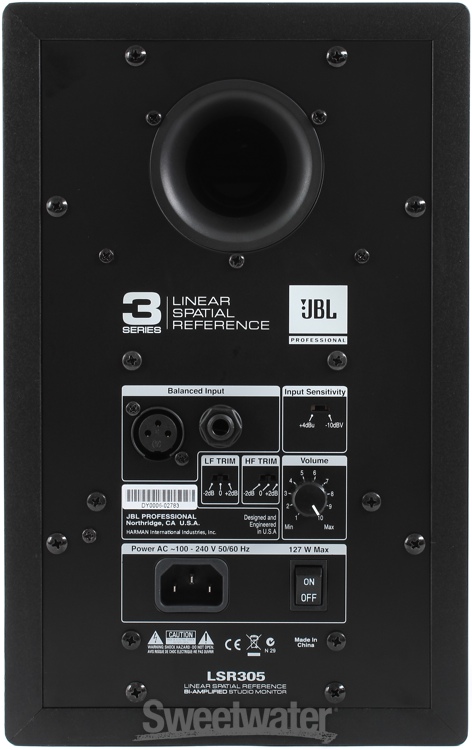
For the price of this speaker, the HF with the waveguide outperforms just about every dome tweeter I can see out there from a polar uniformity standpoint. I think using one of these high passed at say 400Hz in a XO with a nice 12in woofer can make for a very good multiway speaker.
Last edited:
Simple way to achieve phase overlap is to make the roll-off symmetrical in shape. Remember this and multi-way can sound better than FR in every aspects.
I doubt that to be true.... the part of Multi way being superior to FR. Not valid for most multi way designs anyway.
I doubt that to be true.... the part of Multi way being superior to FR. Not valid for most multi way designs anyway.
Indeed you are right... the part of most multi-way (actually all IME) being inferior in that certain aspect.
What I know for sure is... side by side comparison, my 2-way outperform FR drivers in certain aspects I have never believed was possible before.
- Home
- Loudspeakers
- Full Range
- 10F/8424 & RS225-8 FAST / WAW Ref Monitor